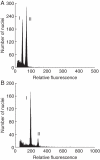Apomixis is not prevalent in subnival to nival plants of the European Alps
- PMID: 21724654
- PMCID: PMC3143052
- DOI: 10.1093/aob/mcr142
Apomixis is not prevalent in subnival to nival plants of the European Alps
Abstract
Background and aims: High alpine environments are characterized by short growing seasons, stochastic climatic conditions and fluctuating pollinator visits. These conditions are rather unfavourable for sexual reproduction of flowering plants. Apomixis, asexual reproduction via seed, provides reproductive assurance without the need of pollinators and potentially accelerates seed development. Therefore, apomixis is expected to provide selective advantages in high-alpine biota. Indeed, apomictic species occur frequently in the subalpine to alpine grassland zone of the European Alps, but the mode of reproduction of the subnival to nival flora was largely unknown.
Methods: The mode of reproduction in 14 species belonging to seven families was investigated via flow cytometric seed screen. The sampling comprised 12 species typical for nival to subnival plant communities of the European Alps without any previous information on apomixis (Achillea atrata, Androsace alpina, Arabis caerulea, Erigeron uniflorus, Gnaphalium hoppeanum, Leucanthemopsis alpina, Oxyria digyna, Potentilla frigida, Ranunculus alpestris, R. glacialis, R. pygmaeus and Saxifraga bryoides), and two high-alpine species with apomixis reported from other geographical areas (Leontopodium alpinum and Potentilla crantzii).
Key results: Flow cytometric data were clearly interpretable for all 46 population samples, confirming the utility of the method for broad screenings on non-model organisms. Formation of endosperm in all species of Asteraceae was documented. Ratios of endosperm : embryo showed pseudogamous apomixis for Potentilla crantzii (ratio approx. 3), but sexual reproduction for all other species (ratios approx. 1·5).
Conclusions: The occurrence of apomixis is not correlated to high altitudes, and cannot be readily explained by selective forces due to environmental conditions. The investigated species have probably other adaptations to high altitudes to maintain reproductive assurance via sexuality. We hypothesize that shifts to apomixis are rather connected to frequencies of polyploidization than to ecological conditions.
Figures


Similar articles
-
Plant apomixis is rare in Himalayan high-alpine flora.Sci Rep. 2019 Oct 7;9(1):14386. doi: 10.1038/s41598-019-50907-5. Sci Rep. 2019. PMID: 31591463 Free PMC article.
-
Timing of sexual reproduction and reproductive success in the high-mountain plant Saxifraga bryoides L.Plant Biol (Stuttg). 2007 Nov;9(6):683-93. doi: 10.1055/s-2007-965081. Epub 2007 May 31. Plant Biol (Stuttg). 2007. PMID: 17538865
-
Reproductive differentiation into sexual and apomictic polyploid cytotypes in Potentilla puberula (Potentilleae, Rosaceae).Ann Bot. 2013 Oct;112(6):1159-68. doi: 10.1093/aob/mct167. Epub 2013 Aug 19. Ann Bot. 2013. PMID: 23960045 Free PMC article.
-
The genetic control of apomixis: asexual seed formation.Genetics. 2014 Jun;197(2):441-50. doi: 10.1534/genetics.114.163105. Genetics. 2014. PMID: 24939990 Free PMC article. Review.
-
Apomixis: a developmental perspective.Annu Rev Plant Biol. 2003;54:547-74. doi: 10.1146/annurev.arplant.54.110901.160842. Annu Rev Plant Biol. 2003. PMID: 14503003 Review.
Cited by
-
What does the geography of parthenogenesis teach us about sex?Philos Trans R Soc Lond B Biol Sci. 2016 Oct 19;371(1706):20150538. doi: 10.1098/rstb.2015.0538. Philos Trans R Soc Lond B Biol Sci. 2016. PMID: 27619701 Free PMC article. Review.
-
Geographical Parthenogenesis in Alpine and Arctic Plants.Plants (Basel). 2023 Feb 13;12(4):844. doi: 10.3390/plants12040844. Plants (Basel). 2023. PMID: 36840192 Free PMC article. Review.
-
Geographical parthenogenesis and population genetic structure in the alpine species Ranunculus kuepferi (Ranunculaceae).Heredity (Edinb). 2013 Jun;110(6):560-9. doi: 10.1038/hdy.2013.1. Epub 2013 Feb 13. Heredity (Edinb). 2013. PMID: 23403961 Free PMC article.
-
Correlations of polyploidy and apomixis with elevation and associated environmental gradients in an alpine plant.AoB Plants. 2016 Oct 27;8:plw064. doi: 10.1093/aobpla/plw064. Print 2016. AoB Plants. 2016. PMID: 27594702 Free PMC article.
-
Plant apomixis is rare in Himalayan high-alpine flora.Sci Rep. 2019 Oct 7;9(1):14386. doi: 10.1038/s41598-019-50907-5. Sci Rep. 2019. PMID: 31591463 Free PMC article.
References
-
- Aliyu OM, Schranz ME, Sharbel TF. Quantitative variation for apomictic reproduction in the genus Boechera (Brassicaceae) American Journal of Botany. 2010;97:1719–1731. - PubMed
-
- Asker SE, Jerling L. Apomixis in plants. Boca Raton, FL: CRC Press; 1992.
-
- Baker HG. Support for Bakers law – as a rule. Evolution. 1967;21:853–856. - PubMed
-
- Barcaccia G, Arzenton F, Sharbel T, Varotto S, Parrini P, Lucchin M. Genetic diversity and reproductive biology in ecotypes of the facultative apomict Hypericum perforatum L. Heredity. 2007;96:322–334. - PubMed
-
- Bell G. The masterpiece of nature: the evolution and genetics of sexuality. Berkeley, CA: California Press; 1982.

